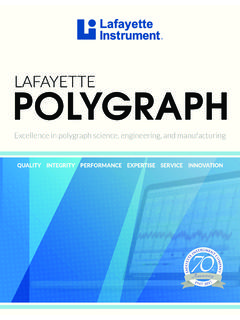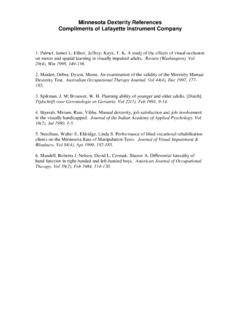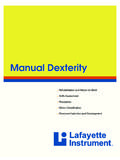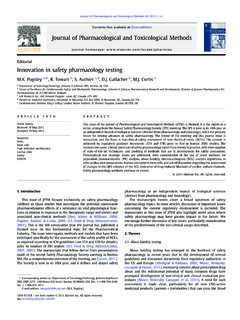Transcription of The McIlwain Tissue Chopper - limef.com
1 The McIlwain Tissue Chopper This apparatus has been designed to prepare pieces of Tissue for metabolic experiments and to be especially applicable to small and irregular specimens available at biopsy or from small organs. Its special features are to cause much less disturbance of cell structure than homogenisers or blenders and to be applicable to fragments that would be difficult or impossible to cut by ordinary methods. Typical applications are to liver, kidney and various parts of the central nervous system. Slices up to 1mm thick and cubes and prisms up to 1mm cross section can be prepared with the Chopper in 30. seconds.
2 Provision is made for stepless variation of slice thickness from zero to the maximum by means of a micrometer head calibrated in microns. The action of the machine is as follows: a circular stainless steel table, on which the specimen is placed, is traversed automatically from left to right of the machine. At the same time a chopping arm carrying a blade is raised and dropped rapidly by an adjustable force. As the table carrying the Tissue passes under the blade it is chopped into the required slices. If prisms are required the table is returned to the left hand side of the machine, turned through 45 degrees, and the process repeated.
3 Cubes are formed by rotating the table 90 degrees. The cutting speed can be varied from zero to over 200 strokes per minute. A safety limit switch is provided to prevent the machine overrunning and a quick release mechanism for the return of the table. Instructions for The McIlwain Tissue Chopper IMPORTANT. The McIlwain Tissue Chopper must be fitted with a three-pin plug and only connected to an supply having a voltage corresponding to that marked on the appliance. When a fused plug is used it should be fitted with a 3 amp fuse, if in doubt consult a qualified electrician, since these instructions must be observed. The wires in the mains lead supplied with this appliance are coloured in accordance with the following code.
4 Green and Yellow : Earth Blue : Neutral Brown : Live As these colours may not correspond with coloured markings identifying the terminals in your plug, connect as follows: The Green and Yellow to the terminal marked with the letter E or by the earth symbol or coloured green and yellow. The Blue wire to the terminal marked N or coloured blue. The Brown wire to the terminal marked L or coloured brown. WARNING: THIS APPLIANCE MUST BE EARTHED. Use the Tissue Chopper on a firm bench and do not restrict ventilation by using in a confined space. Clean the Tissue Chopper with a dry cloth, we do not recommend the use of solvents. To sterilise the blade holder, cutting table and plastic disc see Operating Procedure.
5 If an object is accidentally dropped into the Tissue Chopper , immediately disconnect from the main electricity supply and retrieve the object. If the equipment has been dropped or damaged in any way, it should be checked before connecting to the mains supply. Similarly, although the equipment is lubricated for life, any work [especially involving the removal of covers] must be carried out by a competent Service Engineer. In the interest of safety, always use the equipment in the specified manner. BY NATURE OF ITS USE, THIS INSTRUMENT DOES NOT HAVE A GUARD AROUND THE. CUTTING BLADE. IN THE INTEREST OF SAFETY, CARE MUST THEREFORE BE.
6 EXERCICESD WHEN USING THIS EQUIPMENT. AT ALL TIMES KEEP HANDS CLEAR OF THE. BLADE AND CUTTING TABLE WHEN THE INSTRUMENT IS SWITCHED ON. WE. RECOMMEND THE BLADE IS REMOVED WHEN THE APPARATUS IS NOT IN USE. SETTING UP PROCEDURE (WITH THE INSTRUMENT SWITCHED OFF). 1. SLICE THICKNESS. The thickness of slice is adjusted by means of the micrometer head. The maximum thickness is 1 mm. Each division on the thimble represents 1 micron. Each small division on the barrel represents 25 microns. 2. BLADE FORCE. The force of the blade can be adjusted by turning the Blade Force Knob. To increase force turn the knob in a clockwise direction.
7 3. POSITIONING THE BLADE. Three or more filter papers of the correct diameter are placed on the circular plastic disc and held in place by the two spring clips on the table. Turn the Manual Operating Knob clockwise until the chopping arm falls. (IMPORTANT: THIS KNOB MUST NOT BE TURNED ANTICLOCKWISE). Remove Blade Clamping Plate and fit a blade, replace the clamp plate loosely attaching the nut. With the blade resting on the top filter paper along its length, tighten the clamp plate nut with the spanner provided. If this setting cannot be achieved, slacken the two blade holder attachment nuts, adjust the blade holder to suit and retighten.
8 When the machine is switched on it will probably cut the top filter paper. After first switching off, remove this paper and the Tissue Chopper is ready to take a specimen Note: Alternatively the specimen may be attached to the plastic disc without the use of the filter papers. OPERATING PROCEDURE. To bring the table to the starting position, pull out the Table Release Knob, slide it to the left and release it. Place the specimen on the centre of the table, switch on and press the Reset Switch. The speed may be adjusted with the Speed Control Knob clockwise to increase. After the Tissue has been cut into slices, the machine will automatically stop when the table reaches the end of its travel.
9 If it is required to cut the Tissue into cubes, the table may be rotated through 90 and the procedure repeated. If the blade holder is removed for sterilising, we recommend sliding a piece of paper under the blade holder to prevent the nuts and washers dropping into the instrument. After sterilising the cutting table, apply a little paraffin wax to the underside before replacing it on the mounting disc. SPECIFICATION. RATING : 220-240 volts 50 hz amp or 100-115 volts 60 hz 1 amp FUSES : amp. Anti-surge (T) 5 x 2 Omm OPERATING CONDITIONS : Indoor use Altitude up to 2000 metres Ambient temperature 5 C to 40 C. Maximum RH 80% at 31 C decreasing linearly to 50% RH at 40 C.
10 Installation Category II. Pollution degree I or 2 (IEC 664). DIMENSIONS : 31 x x 15 cms WEIGHT : kg WARRANTY. This product is guaranteed against defects arising from faulty workmanship or materials for a period of one year from the original date of purchase, provided that the product has been used solely within the guidelines set by the operation instructions. Return the equipment to us and we will rectify the fault free of charge. This guarantee in no way affects your rights under statutory law. Manufactured by The Mickle Laboratory Engineering Co. Ltd. Goose Green, Gomshall, Guildford, Surrey GU5 9LJ. UK. Tel/Fax: +44 (0)1483 202178.





